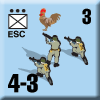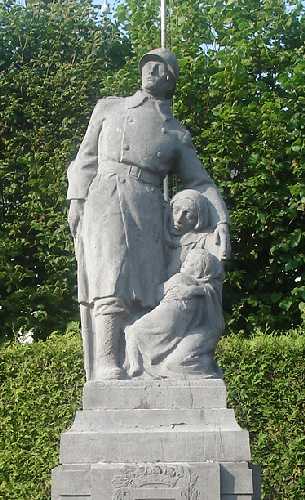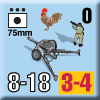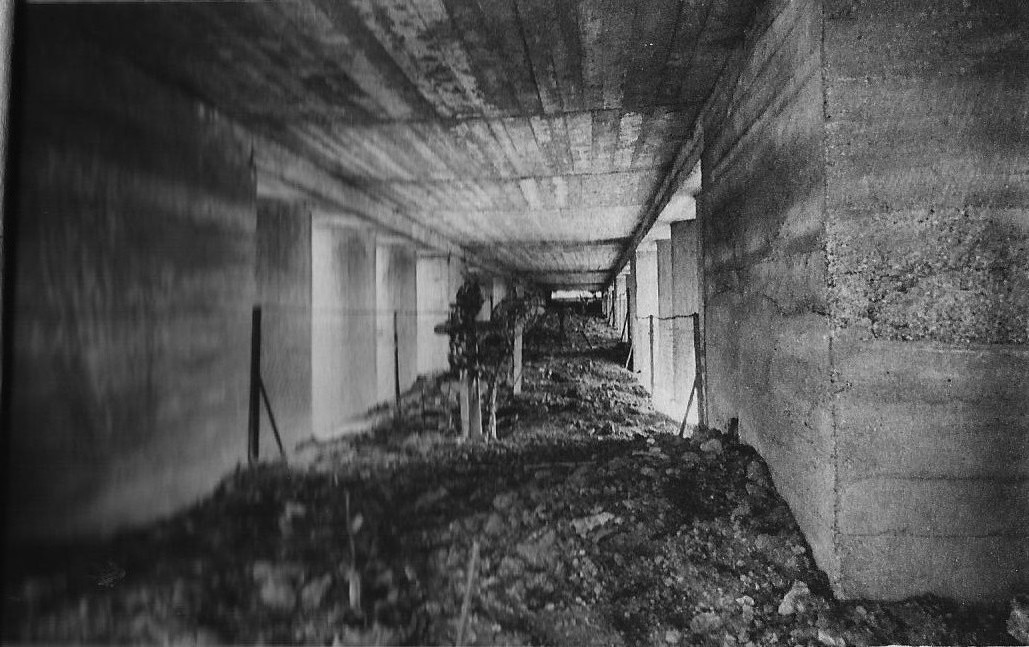| 1940: The Last Days of May
Scenario Preview, Part One
By Mike Bennighof, Ph.D.
January 2023
 The new Playbook edition of Panzer Grenadier: 1940 The Fall of France added so much new material to the game – it’s pretty much a new game at this point,just one that uses the same maps and pieces – that we couldn’t fit it all into the book. So we added a Campaign Study, 1940: The Last Days of May, to accommodate the leftovers. Designer Philippe Léonard promptly added still more new scenarios, which makes 1940: The Last Days of May much more than a book of leftovers. The new Playbook edition of Panzer Grenadier: 1940 The Fall of France added so much new material to the game – it’s pretty much a new game at this point,just one that uses the same maps and pieces – that we couldn’t fit it all into the book. So we added a Campaign Study, 1940: The Last Days of May, to accommodate the leftovers. Designer Philippe Léonard promptly added still more new scenarios, which makes 1940: The Last Days of May much more than a book of leftovers.
The new scenarios are necessary, to flesh out the narrative. Both 1940: The Fall of France’s Playbook Edition and 1940: The Last Days of May follow our story-arc structure, with the scenarios organized into chapters so they can tell the story of the campaign. Each chapter has a battle game, that lets you play all of the scenarios in the chapter and measure your performance.
Let’s have a look at the first chapter of 1940: The Last Days of May. The chapter and scenario numbering sequence picks up from the end of 1940: The Fall of France.
Chapter Eight
The Dunkirk Pocket

When the German 2nd Panzer Division reached the English Channel at Abbeville on 20 May, a large Allied force became trapped in a pocket around the ports of Calais and Dunkirk. The French First Army, British Expeditionary Force and Belgian Army between them numbered some 400,000 men, now trapped as an even larger German force pressed them against the sea.
On the evening of 23 May, Gerd von Rundstedt of Army Group A ordered a halt to re-organize his front lines; Adolf Hitler arrived at his headquarters the next morning and at 1245 made the order general across the German front. Just why he did so would be debated for decades afterwards, but it seems to have a simple explanation: Rundstedt and Hitler shared a great deal of anxiety over the chaotic advance of their armored forces and feared an Allied counter-stroke.
The Allies would indeed attempt multiple counter-attacks, which slowed the German advance but did not create the feared disaster. The British already looked to evacuate the Continent, the Belgians would surrender on the 28th, while the French First Army fought to hold off the advancing Germans.
Scenario Forty-One
Before the Stop Order
24 May 1940
Along the Aa Canal, Southeast of Dunkirk
 The British and French troops trapped at Dunkirk prepared to evacuate behind whatever thin defensive lines they could muster. But the panzer divisions facing them had outrun their own supply echelon and been exhausted by constant combat. They could not hope to strike the final blow. The Germans therefore released 1st Panzer Division from its mission reducing the defenses around Calais and sent it eastward toward the canalized Aa River. At St-Nicolas and La Bistade (south of Gravelines), a collection of cavalry, infantry and old anti-aircraft trucks defended the bridges across the canal, but not any other locations. Infantry Regiment Grossdeutschland (attached to 1st Panzer Division) would establish and consolidate a bridgehead on the Aa River. The first firefights erupted the night before Hitler ordered a halt to the German attack on Dunkirk. The British and French troops trapped at Dunkirk prepared to evacuate behind whatever thin defensive lines they could muster. But the panzer divisions facing them had outrun their own supply echelon and been exhausted by constant combat. They could not hope to strike the final blow. The Germans therefore released 1st Panzer Division from its mission reducing the defenses around Calais and sent it eastward toward the canalized Aa River. At St-Nicolas and La Bistade (south of Gravelines), a collection of cavalry, infantry and old anti-aircraft trucks defended the bridges across the canal, but not any other locations. Infantry Regiment Grossdeutschland (attached to 1st Panzer Division) would establish and consolidate a bridgehead on the Aa River. The first firefights erupted the night before Hitler ordered a halt to the German attack on Dunkirk.
Conclusion
At dawn, the Germans attacked all along the canal line, which presented the last major obstacle before Dunkirk itself. Some Germans attacked the bridges while others crossed the canal in small boats and hit the French in the flanks near St-Nicolas and La Bistade. The bridges’ defenders had no reserves to call on, but their mortars and autocannon slowed the Germans enough to allow for an orderly retreat despite heavy losses.
Notes
A scenario based on this action appeared in the first edition of 1940: The Fall of France, but Philippe gave it a complete replacement. It’s a small-scale infantry action, with the Grossdeutschland Regiment on the attack against a disparate group of French defenders making a stand behind a canal.
Scenario Forty-Two
Ancient Walls
24 May 1940
Gravelines, France
 Along the Aa River, from Petit-Fort-Philippe to Gravelines, the Allies gathered a jumbled assortment of troops to block Route Nationale Nr. 40 leading to Calais and Dunkerque. In addition to the French troops and artillery, a British battalion, the 6th Green Howards, garrisoned the old city of Gravelines with its canals, bridges and Vauban-era fortifications. During the night, four British tanks led by Major W. R. Reeves joined the city’s defenders, who concentrated their forces to cover the three standing bridges over the canal on the west side of the city. In the morning, a German cyclist recon party approached. The enemy’s main force could not be far behind. Along the Aa River, from Petit-Fort-Philippe to Gravelines, the Allies gathered a jumbled assortment of troops to block Route Nationale Nr. 40 leading to Calais and Dunkerque. In addition to the French troops and artillery, a British battalion, the 6th Green Howards, garrisoned the old city of Gravelines with its canals, bridges and Vauban-era fortifications. During the night, four British tanks led by Major W. R. Reeves joined the city’s defenders, who concentrated their forces to cover the three standing bridges over the canal on the west side of the city. In the morning, a German cyclist recon party approached. The enemy’s main force could not be far behind.
Conclusion
 A German armored column drove down RN 40 at about 1030, rolling through a crowd of refugees without any shooting. When they reached the Vauban lock-bridge, the defence woke up and quickly destroyed four vehicles. More than 20 tanks stood in front of the two main bridges, firing continuously to allow the German infantry to advance under cover. A German armored column drove down RN 40 at about 1030, rolling through a crowd of refugees without any shooting. When they reached the Vauban lock-bridge, the defence woke up and quickly destroyed four vehicles. More than 20 tanks stood in front of the two main bridges, firing continuously to allow the German infantry to advance under cover.
In front of lock 63bis, a French 25mm anti-tank gun supported by the British tanks destroyed more tanks and repulsed the attack. While truck-borne German infantry tried to assault the defenses, heavy rifle fire from the ramparts pinned them down on the ground. Not even a renewed bombardment broke the resistance. Both the French and British claimed many German tanks and vehicles destroyed.
Meanwhile, hundreds of Dutch, Belgian and French civilian refugees had been trapped in the moat in front of Fort Petit-Saint-Philippe. Subjected to rifle and machine-gun fire from both sides, strafing runs by Allied aircraft and German artillery, over 200 people died in the mud with many more wounded. French soldiers braved the hellstorm to drag children and wounded into Fort Grande-Saint-Philippe, where a group of displaced Belgian medical students operated with a collection of scissors taken from a nearby school. When the firing died down, citizens of Gravelines came out to rob the corpses.
Notes
This is a brand-new scenario, with the French and British (you’ll need pieces and maps from Road to Dunkirk, too) holding a fortified river line. But the fortifications are from the 17th Century, so they’re only of limited help. I hesitated to include a scenario drawing on another game for parts, but this one’s so good that I couldn’t leave it out.
Scenario Forty-Three
Trench of Bayonets
25 May 1940
St-Georges, Southeast of Gravelines
 While the Germans consolidated their bridgeheads across the Aa and rested after Hitler’s stop order, the French command at Dunkirk built up strong artillery support groups and ordered a counterattack against the small village of St-Georges to restore their lines. The 137th Infantry Regiment, part of 21st Infantry Division, had defended Verdun on 12 June 1916 when one of its companies was buried alive in the Trench of Bayonets. This generation was no more willing to yield to the invaders. While the Germans consolidated their bridgeheads across the Aa and rested after Hitler’s stop order, the French command at Dunkirk built up strong artillery support groups and ordered a counterattack against the small village of St-Georges to restore their lines. The 137th Infantry Regiment, part of 21st Infantry Division, had defended Verdun on 12 June 1916 when one of its companies was buried alive in the Trench of Bayonets. This generation was no more willing to yield to the invaders.
Conclusion
The French counterattack started at 0900, backed by artillery support and a handful of tanks. The unsupported German recon troops in the village fled after calling in some artillery fire and airstrikes that failed to stop the French. At noon the French infantry reached its main objective (the railway embankment dominating the surrounding landscape) and the Germans fell back to the bridge of St-Folquin. This small victory showed that the French would keep defending Dunkirk as fiercely as they had Verdun. Over a century later, the 137th Infantry Regiment’s Third Company still holds its trench.

Notes
It’s just a small scenario, with a French infantry battalion on the attack against a gaggle of German motorcyclists and their supporting arms. A version of this scenario appeared in 1940: The Fall of France.
Scenario Forty-Four
La Vieille Garde
29 May 1940
South of Furnes (Veurne), Belgium
 The French 60th Infantry Division, a Series B outfit composed of older reservists and missing much of its allotted equipment eight months after mobilization, marched into Belgium in early May. Its commander was killed in action and the division took heavy losses in its initial contacts with the enemy. As the last French division still directly supporting the Belgian Army, the 60th Infantry Division was left exposed by the 28 May surrender of its allies. The tired, dispirited men took up positions along the line of the Yser Canal, marching along roads littered with the weapons and equipment abandoned by their British allies. The French 60th Infantry Division, a Series B outfit composed of older reservists and missing much of its allotted equipment eight months after mobilization, marched into Belgium in early May. Its commander was killed in action and the division took heavy losses in its initial contacts with the enemy. As the last French division still directly supporting the Belgian Army, the 60th Infantry Division was left exposed by the 28 May surrender of its allies. The tired, dispirited men took up positions along the line of the Yser Canal, marching along roads littered with the weapons and equipment abandoned by their British allies.
On 29 May, the German attacks began at dawn. The whole northern part of the line defended by the 270th Infantry Regiment collapsed under the assault, opening the road to Furnes. The 241st Infantry Regiment, although seriously threatened, held on to the Pervise-Dixmude line. At 1230, the order to withdraw to the Loo Canal held by the 2nd DLM finally arrived, but the Germans had already reached the waterway in the vicinity of Furnes.
Conclusion
The French withdrawal had been compromised by Germans already driving along the Route Nationale 67 between Pervise and Furnes. Few French units, overwhelmed and surrounded, managed passage toward the rear. In the 60th Infantry Division’s 50th Artillery Regiment, the gunner sabotaged some pieces, air attacks claimed others, and the Germans captured still more on the road. The division’s last units did not pull out until 1500, assisted by a handful of tanks from 2nd DLM. The dramatic withdrawal cost the 60th Infantry Division most of its remaining combat strength, but its resistance halted the German advance for a day along the Loo Canal. The division’s last 3,500 men made it to the Dunkerque beaches, protected by the one company that still had its weapons. Royal Navy liaison officers promised that they would be taken off on 3 June, but no boats arrived and the division’s remnants surrendered the next morning.
Notes
This is a new scenario, and it’s an odd one, with the French trying to get over the river and then off the board, but the Germans are coming in from the flank. That means that the French can’t just cut and run, but have to balance resistance against retreat, to hang onto the bridges long enough for their comrades coming from the east to get across. It’s a fine puzzle for both players.
Scenario Forty-Five
Road to Dunkirk
3 June 1940
South of Dunkirk, France
 The last British troops evacuated from Dunkirk the night of 2 June, and on the morning of the 3rd the French made a desperate effort to hold the lines while evacuating as many of their own troops as possible. Few men and weapons could be found for the last-ditch defense beyond courageous volunteers from 7th Groupement de Reconnaissance and 224th Infantry Regiment. The 224th Infantry Regiment, down to one battalion, had already been evacuated once – from Vlissingen in the Netherlands to Dunkirk – but this time the Series B reservist outfit would stand and fight. The last British troops evacuated from Dunkirk the night of 2 June, and on the morning of the 3rd the French made a desperate effort to hold the lines while evacuating as many of their own troops as possible. Few men and weapons could be found for the last-ditch defense beyond courageous volunteers from 7th Groupement de Reconnaissance and 224th Infantry Regiment. The 224th Infantry Regiment, down to one battalion, had already been evacuated once – from Vlissingen in the Netherlands to Dunkirk – but this time the Series B reservist outfit would stand and fight.
Conclusion
South of Dunkirk on the road to Bergues, French forces held fast at the Sept-Planètes crossroads and bridge. They inflicted heavy losses on the Germans, and around 1100 the attack slowed as no German wanted to be the last man killed before final victory. Trading ground for time, the heroic French soldiers held back the German tide until nightfall. Sadly, they did their job too well: they held the line until after the last boat left the Dunkirk beaches, and most would be captured the next day in the nearly-deserted city.
Notes
Once again, we had a scenario in the first edition of 1940: The Fall of France that covered this action, but it didn’t satisfy Philippe. The unfortunate changes made in development have been reversed here as well, and now you get a re-developed scenario that more closely represents what actually happened.
And that’s it for Chapter Eight. Next time, we study Chapter Nine.
You can order 1940: The Fall of France right here.
Please allow an extra two weeks for delivery.
You can order 1940: The Last Days of May right here.
Please allow an extra two weeks for delivery.
Sign up for our newsletter right here. Your info will never be sold or transferred; we'll just use it to update you on new games and new offers.
Mike Bennighof is president of Avalanche Press and holds a doctorate in history from Emory University. A Fulbright Scholar and NASA Journalist in Space finalist, he has published a great many books, games and articles on historical subjects; people are saying that some of them are actually good.
He lives in Birmingham, Alabama with his wife, three children, and new puppy. He misses his lizard-hunting Iron Dog, Leopold.
Want to keep Daily Content free of third-party ads? You can send us some love (and cash) through this link right here.
|
